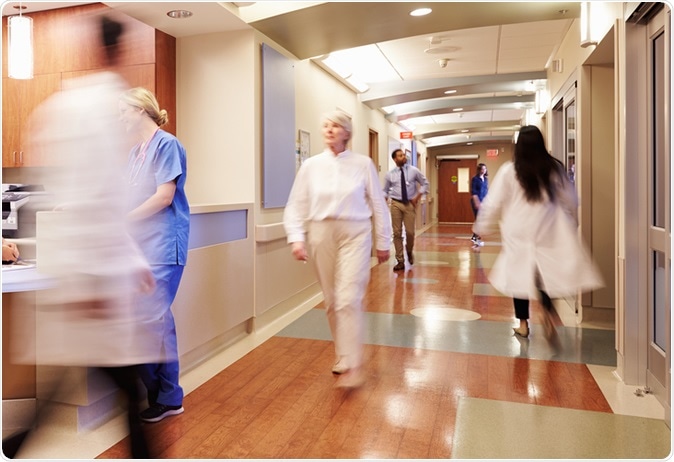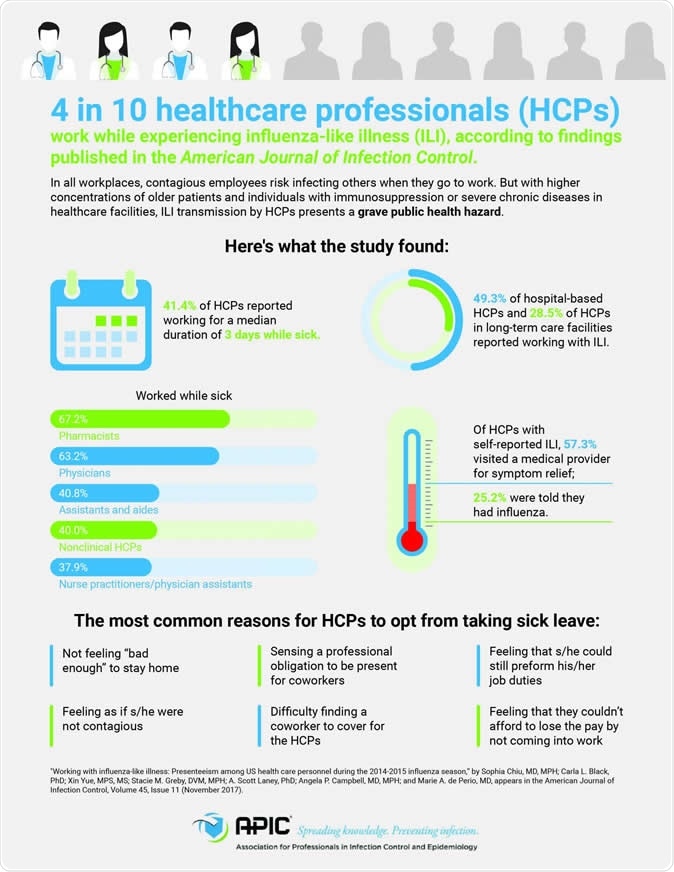According to a new study, 4 in 10 health care professionals are turning up for work even when they are down with a contagious infection such as a flu. The study titled, “Working with influenza-like illness: Presenteeism among US health care personnel during the 2014-2015 influenza season”, was published in the November issue of the American Journal of Infection Control (AJIC).

4 in 10 Healthcare Professionals Work while Sick. Image Credit:Monkey Business Images / Shutterstock
The authors of the study say that the same health care professionals advise patients with influenza-like-illnesses to stay at home when sick to stop the spread of the infections to other persons.
Healthcare professionals who take the risk of showing up for work when ill with these flu like ailments risk passing them on to infants, children and elderly patients and those with a compromised or reduced immunity since many such individuals present to the healthcare facilities.
Patients with long term chronic ailments are also at risk of contracting these infections. Unlike otherwise healthy persons, these vulnerable individuals are more at risk of developing life threatening infections and complications.

4 in 10 healthcare professionals (HCPs) work while experiencing influenza-like illness (ILI) according to findings published in the American Journal of Infection Control. CREDIT APIC
Additionally the spread of the infections to the community also poses a serious public health hazard.
Lead researcher Sophia Chiu, MD, MPH, CDC's National Institute for Occupational Safety and Health called these numbers alarming explaining that patients are exposed to “healthcare associated infection” which they are five times more likely to contract when they come in contact with a healthcare professional who reports with a flu like illness. She added, “We recommend all healthcare facilities take steps to support and encourage their staff to not work while they are sick.”
The study was conducted via a national online survey that looked at 1914 healthcare professionals during the flu season of 2014 and 2015.
Healthcare professionals included not only physicians but also physician’s assistants, nurses, pharmacists, assistants, clinical health care providers as well as nonclinical health care providers and residents and students.
Work settings assessed included hospitals, ambulatory care set ups, physician’s chambers and long term care facilities.
They asked the participants of the survey to report symptoms of flu and flu like illnesses such as a fever, sore throat, cough runny nose etc.
They also asked the respondents to list the reasons and factors that prompt them to report for work despite having the infection.
Results revealed that of all the respondents, 414 reported an incidence of influenza like illness during the study period. Of these, 41.4 percent or 183 healthcare professionals showed up for work for an average of three days while they were experiencing the symptoms of influenza like illness.
According to the Centers for Disease Control and Prevention, CDC recommendation, persons with flu like illness should wait for 24 hours after fever breaks before they can come back to work.
In terms of the four types of set ups that were studied, hospital based ones were most likely to have health care professionals showing up for work (almost one in two – 49.3 percent). Among long term care facilities, 28.5 percent showed up for work.
Clinical professionals who deal with patients first hand were most likely to report for work with symptoms (44.3 percent). Among these 67.3 percent pharmacists and 63.2 percent physicians worked with the symptoms of flu.
On the other hand 40.8 percent assistants, 40.4 percent nonclinical professionals, 37.9 percent nurses and physician’s assistants and 32.1 percent other clinicians worked while they were down with flu like symptoms.
As the other part of the study, the team of researchers looked at the reasons why these healthcare professionals opted for working rather than taking sick leaves.
The commonest reason cited was the fact that most of the respondents felt they did not feel “bad enough” not to work. They said they felt a professional obligation to a co-worker to not be absent from work and many said they did not find a co-worker to cover for them during their sick leaves.
Some (39 percent) sought medical help when they were working despite symptoms.
Over half (54 percent) did not think they were contagious and could spread the infection.
Nearly half (49.8 percent) could not afford to lose pay and thus showed up for work they reported. In another finding, only 3 in 4 (77.3 percent) of these healthcare professionals had received the flu shots that prevents them from contracting flu at work.